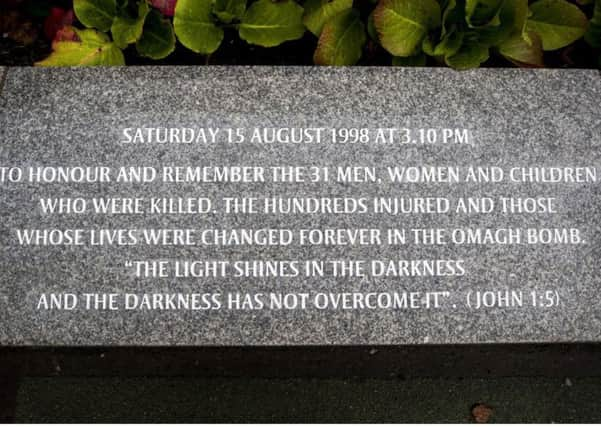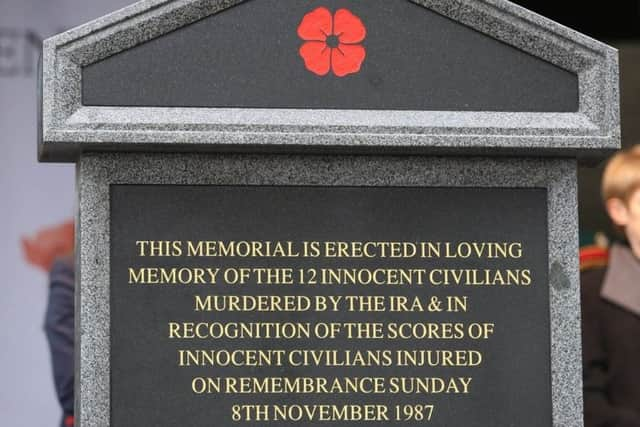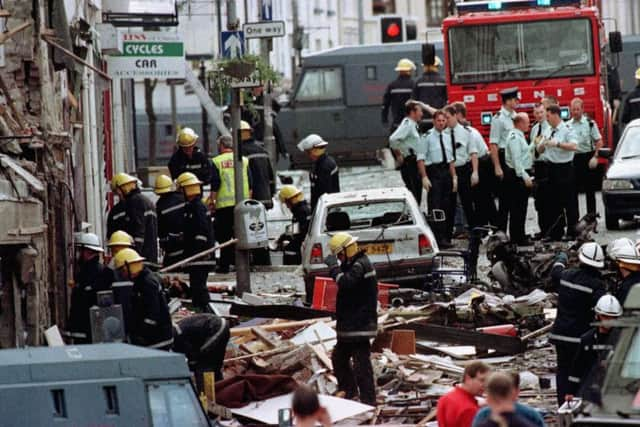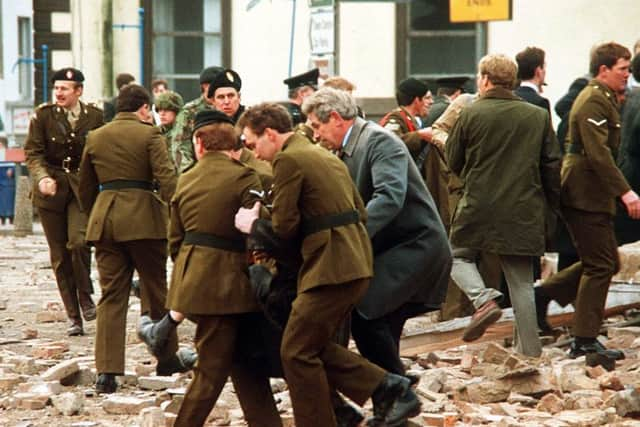Jude Collins has helped us see what many people think about terrorism


Both stones are controversial.
In Enniskillen, there is a dispute over the desire of relatives to put a memorial at the blast site (the News Letter spoke to a close relative of all but one of the 12 people murdered in 1987, and all backed its placing).
The Catholic Church says the size of the construction posed “insurmountable” problems with locating it at the site on land it owns.


Advertisement
Hide AdAdvertisement
Hide AdThe church has denied that the diocesan trust expressed a view on the presence of a poppy symbol on the memorial but other voices have questioned the sensitivity of that aspect of the design.
In Omagh, there was a row over wording on their memorial. Some families wanted it to say their loved ones were murdered in a “terrorist” bomb. They blamed the Sinn Fein-dominated council for blocking it.
The row was mediated by a group, headed by the former Presbyterian moderator Dr John Dunlop. A compromise led to the less contentious wording used on an engraving at the site of the blast (pictured top) and a wall leading to a remembrance garden.
The families’ preferred wording (To ‘... remember 31 people murdered and hundreds injured from three nations by a dissident republican terrorist car bomb’) was used on a wall in the garden. Dr Dunlop said it was “a long narrative ... so we decided we were going to put a long story about what happened in the context of the day ...”


Advertisement
Hide AdAdvertisement
Hide AdA fact of that outcome, however, is that on Omagh’s 20th anniversary photographers and media were naturally drawn to the engraving at the site, and it is the one that has the mild words.
Contrast that wording, ‘To ... remember the 31 men, women and children who were killed. The hundreds injured and those whose lives were changed forever in the Omagh bomb,’ with the wording at Enniskillen.
The latter remembers ‘...the 12 innocent civilians murdered by the IRA and ... the scores of innocent civilians injured on Remembrance Sunday 8th November 1987’.
There is, arguably, a dignity to wording that just refers to the human loss of a catastrophe such as Omagh. But it is also arguable that neutral wording about people who were “killed” or whose “lives were changed forever in the Omagh bomb” is so passive as almost to insult the memory of what happened — a massacre of civilians carried out by savages.


Advertisement
Hide AdAdvertisement
Hide AdI have the latter reaction when I hear that republicans in the council opposed blunt wording. Given the long heritage of IRA car bomb horrors in Ulster, it hardly seems appropriate that republicans even spoke up on the wording.
This week the commentator Jude Collins questioned whether Omagh was “murder”, on the basis that dissident bombs had warnings.
It is useful when people talk frankly in this way. For example, it is easier to understand the thinking of a republican such as Gerry McGeough, who admits his past ‘active service’ and who did not want the IRA campaign to end, than a past volunteer who lies about their role.
In some cases they lie so much as to have sought libel damages off anyone who identified them as the IRA person they were, or general damages off the state for a supposedly ‘unsafe’ conviction.
Advertisement
Hide AdAdvertisement
Hide AdMr Collins has helped us see what many people think about republican violence, past and present, including people who oppose it. There are people who oppose it, but in mild tones: “Come on guys, quit the gun, let’s have a pint.”
They do not use the word murder or support long jail terms for such activity.
Note the growing excuses for dissidents: the clamour for the release of Tony Taylor, the abject failure of the wider criminal justice system to get tough on bail breaches by people on serious terror charges, and the soft sentences for major dissident offences. Also the criticism of PSNI ‘harassment’ of dissidents in Londonderry.
Nuala O’Loan of course does not support terror and has said that the bombers alone were culpable for Omagh. But by stating that the atrocity could have been prevented she has, no doubt inadvertently, given succour to the apologists.
Advertisement
Hide AdAdvertisement
Hide AdIn 2016 I wrote a semi satirical piece (link below) after people rushed to accept claims that the security forces could have stopped the 1993 Shankill bomb. Don’t be surprised, I wrote, to hear the same about Enniskillen, La Mon, Teebane, etc: “what we had naively assumed to be straightforward IRA bloodbaths”.
I did not then know the state is already being blamed for Teebane. It is happening in Birmingham too.
Much of this is rubbish to divert attention from the undiluted culpability of republicans for their most heinous crimes. And it is embraced by people who hated the RUC.
They pretend to be concerned about the investigative failures of a force they opposed in its pursuit of republicans they admired.
Advertisement
Hide AdAdvertisement
Hide AdNote how the only people facing sanction over the republican Damien McLaughlin skipping bail are the PSNI officers who failed to notice it, not the system that facilitated bail.
We all hope no further dissident atrocity will happen, and if it does we will all condemn it. But soon enough, someone somewhere will blame it on security force ‘failure’.
• This month the News Letter will run essays on the scandal of how legacy has turned against British forces who prevented civil war
• Ben Lowry (@BenLowry2) is News Letter deputy editor